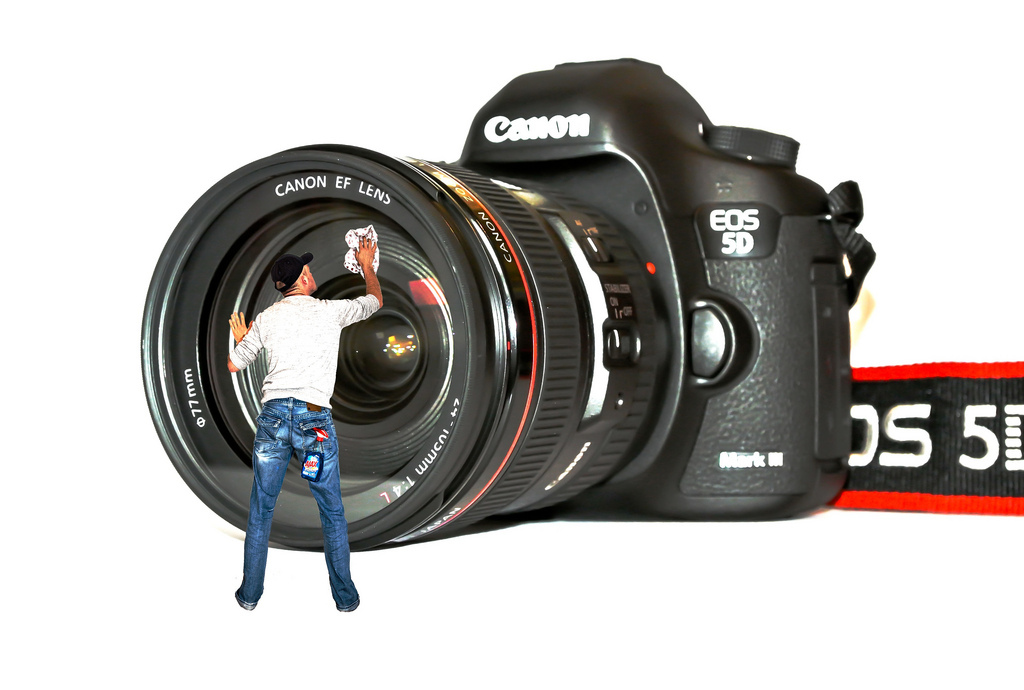
Let’s start with some facts:
- Dirty optics can and will affect your image quality.
- There are correct methods and tools to clean lens and filter optics.
- There are incorrect methods and tools to clean lens and filter optics.
- There’s a great deal of information available on the topic of lens cleaning—some of it conflicting.
So, let’s try to keep things simple, and find the best and safest way to get your lenses clean, so that you can spend more time making photographs, and less time on cleaning chores.
Avoid unnecessary cleaning of your lens
“When you use your gear, it’s going to get dirty.”
Glass is relatively hard and durable. However, when advanced coatings and other chemicals are added to the lens, it becomes a surface that’s more vulnerable to scratches and damage from chemicals and contact. Because of this, we want to try to keep our lenses and filters free of fingerprints and dirt, and avoid repeated physical interaction—this includes touching the lenses and—yes—cleaning.
When stored in your camera bag or on your shelf, judicious use of front and rear lens caps will help keep your optics clean. But, when you use your gear, it’s going to get dirty. This cannot be avoided. Your lenses will benefit from an occasional cleaning of your camera bag innards, as dust and dirt will likely find a home inside your bag and attach itself to the lens.
Dust happens
“Dust is everywhere and everywhere is dust… Dust, however, is not the main enemy.”
Dust is everywhere and everywhere is dust. It will get on and inside your lens. Lenses are manufactured in extremely clean factories, where manufacturers go to great lengths to try to eliminate dust from the environment. Even then, brand-new lenses may have dust between the lens elements.
Dust, however, is not the main enemy. A lens that sits on a shelf in your home for years and collects a thick layer of dust will, obviously, produce image-quality issues. But, a few specs of dust here and there on or inside the lens will have no effect on image quality. A few specs of dust on or inside the lens will have no effect on image quality. That statement was intentionally repeated.
Trying to keep your lenses dust free through continual cleaning may serve to shorten the life of your lens, as you run the risk of scratching the lens surfaces every time you clean the glass.
Beware of rear smudges
Oily fingerprints and smudges on the rear element will have the most dramatic impact on image quality, because of the way that the light is focused narrowly through the back of the lens.
The good news is that the rear element of the lens is less susceptible to dirt and oil because, when mounted on the camera, it isn’t subject to kids’ sticky fingers, your sticky fingers, or other environmental dangers.
Cleaning your optics is easy to do, even in the field
Here is a simple, three-step process for effective lens and filter cleaning:
- Remove as much dust and dirt as possible from the lens with a blower or soft-bristled brush.
- Apply a few drops of lens cleaning solution to a lens tissue or cleaning cloth.
- Using a circular motion, gently remove oil, fingerprints, and grime from the lens surface, working from the center outward.
Remember, you can perform those three easy steps in the field when needed but, unless there are greasy fingerprints or oily smudges on your lens, avoid unnecessary cleaning. You don’t need to be in a dust-free “clean room,” and don a vinyl suit and rubber gloves to clean your lens.
The parts of the lens that are most exposed to the environment are the front element and the barrel of the lens. The best way to protect the front element is to attach a high-quality filter. The filter, generally much less expensive than the lens itself, will serve as a sentry that absorbs the gunk headed for your expensive lens optics. The filter will be cleaned in the same manner as any other lens.
A dirty lens barrel will not degrade image quality, but keeping the lens barrel clean may help avoid potential issues with the mechanics of the focus and zoom mechanisms. Use a lens cloth or tissue and lens-cleaning solution to keep your lens barrel clean.
Brushes and Blowers
When it comes to dust removal by air, the best method is to use a blower, and to avoid using compressed air. Without a blower, you can always blow on the lens with your own lung power, but beware of spraying your lens with saliva or your lunch. A blower should be mandatory equipment in your DSLR camera bag for sensor and lens cleaning.
There is a multitude of lens-cleaning brushes on the market. A high-quality one is recommended. Camel hair works very well. Also, do not touch the brush bristles with your oily fingers, unless you want to transfer grime to the lens while cleaning.
Cloth, Tissues, and Cleaners
“Oily fingerprints and smudges on the rear element will have the most dramatic impact on image quality, because of the way that the light is focused narrowly through the back of the lens.”
Lens tissue is relatively inexpensive. One use only, please. Discard the tissue after cleaning your lens.
Microfiber cleaning cloths are popular as well. There are a few precautions to help ensure their beneficial use. Keep them clean, as they will likely be used for multiple cleanings, and you do not want to re-apply dirt and grime or particles that may scratch your lens. If you wash the cloth, avoid using liquid fabric softeners, as they may leave a chemical residue on the cloth and create streaks on your lens.
Use your cotton t-shirt at your own risk. Again, if the lens does not need cleaning, do not clean it, but if you find yourself separated from your lens-cleaning gear and need to remove a smudge, using a clean 100% cotton t-shirt and warm breath is not the end of the world. Again, avoid liquid fabric softeners. You will find better (and safer) results with dedicated lens-cleaning tissues and cloths.
Cotton swabs are a good option for cleaning, and can be especially effective for cleaning the edges of a lens.
Facial tissue is not recommended, as some brands are abrasive and others contain oils and lotions that can streak your lenses.
Many lens manufacturers market specially formulated lens-cleaning solutions designed to accommodate optical coatings. Again, these are relatively inexpensive, but if you want to make your own solution, or store a 50-gallon drum of the stuff, the use of reagent-grade isopropyl alcohol is recommended. De-ionized water is also safe, but is not a dedicated cleaner and, like moisture from warm breath, will only be effective on water-soluble smudges.
Do not use acetone. Acetone is a great cleaner, but, when used on camera lenses, it could have adverse effects on the plastic and paint of the lens barrel, as well as the optical coatings. Again, do not use acetone.
Using household window cleaners is not recommended on coated optics. Stick to the dedicated lens-cleaning solutions, alcohol, or de-ionized water.
Apply the cleaning solution to the tissue or cloth, instead of directly to the lens. There are several reasons to do so. You want to avoid having beads of liquid running to the edge of the lens element and then entering the lens body. Even weatherproofed lenses might not be watertight, and the liquid may enter the lens body due to capillary action. Liquid droplets function as a lens and may focus sunlight to a point on the glass lens surface creating a super-heated area that could damage the lens or coatings. Also, mild liquids and water can have corrosive properties if left in contact with a surface for a length of time.
Cleaning Technique
Wiping in concentric circles will reduce the occurrences of streaking more than working across the lens.
Working from the center to the edge will move debris to the edges of the lens, away from the center of the image circle, in the event the objects do not get removed.
When wiping, apply only enough pressure to remove the offending smudge.
Lens-Cleaning Miscellany
On a DLSR, when you look through the viewfinder, many times you will see lots of dust specs throughout the image. This dust is on the camera’s mirror, and will not affect the photograph. The mirror can be cleaned, but the silvering is very delicate. Also, using air blowers here may blow dust from your mirror onto your digital sensor, which will definitely affect image quality.
A note to users of sport optics, telescopes, and night photographers: beware of inspecting your lens for cleanliness with a color-filtered flashlight, as some of the dirt and smudges may not appear.
Finally, you may clean your lens mounts (camera and lens) with a cloth and lens-cleaning solution. The digital contacts that allow the lens and camera to communicate may require occasional cleaning. Be sure to use a different cloth from that used for the optics, as wiping a metal lens mount to clean it may impart tiny metal debris on the cloth that should never be introduced to the glass.
Remember the three simple steps, remember that dust happens, and be sure to spend more time making photographs than cleaning your gear.
